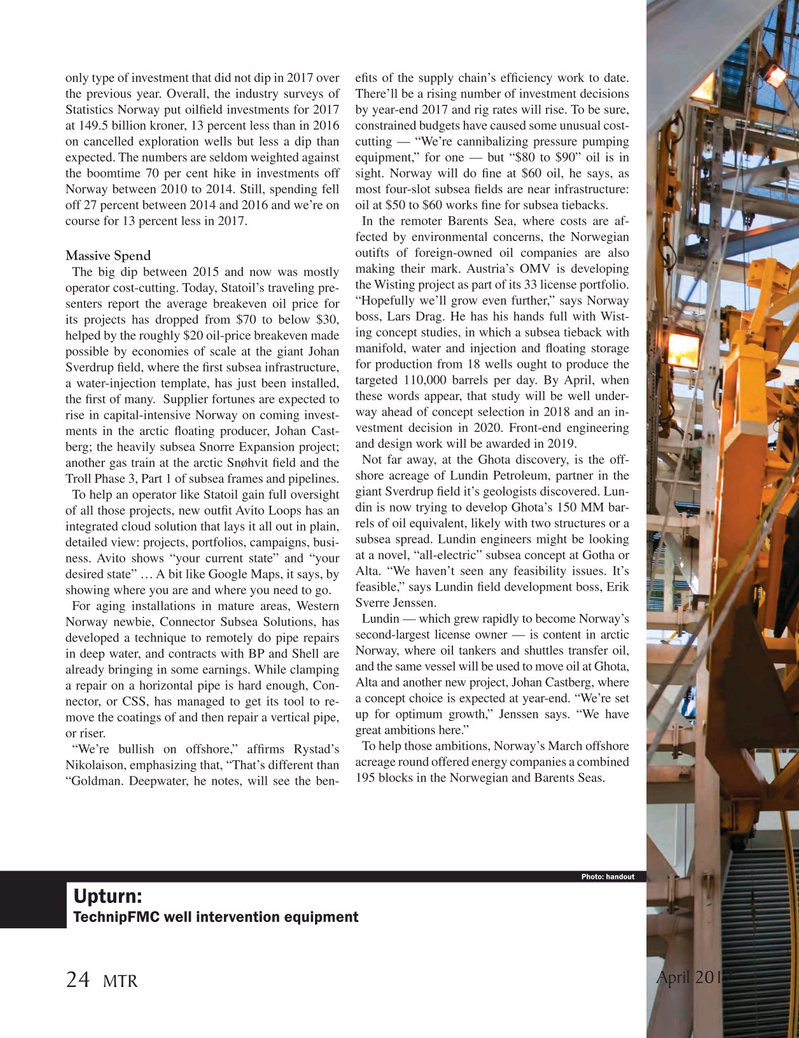
Page 24: of Marine Technology Magazine (April 2017)
Offshore Energy Annual
Read this page in Pdf, Flash or Html5 edition of April 2017 Marine Technology Magazine
only type of investment that did not dip in 2017 over e? ts of the supply chain’s ef? ciency work to date. the previous year. Overall, the industry surveys of There’ll be a rising number of investment decisions
Statistics Norway put oil? eld investments for 2017 by year-end 2017 and rig rates will rise. To be sure, at 149.5 billion kroner, 13 percent less than in 2016 constrained budgets have caused some unusual cost- on cancelled exploration wells but less a dip than cutting — “We’re cannibalizing pressure pumping expected. The numbers are seldom weighted against equipment,” for one — but “$80 to $90” oil is in the boomtime 70 per cent hike in investments off sight. Norway will do ? ne at $60 oil, he says, as
Norway between 2010 to 2014. Still, spending fell most four-slot subsea ? elds are near infrastructure: off 27 percent between 2014 and 2016 and we’re on oil at $50 to $60 works ? ne for subsea tiebacks.
course for 13 percent less in 2017. In the remoter Barents Sea, where costs are af- fected by environmental concerns, the Norwegian outifts of foreign-owned oil companies are also
Massive Spend
The big dip between 2015 and now was mostly making their mark. Austria’s OMV is developing the Wisting project as part of its 33 license portfolio. operator cost-cutting. Today, Statoil’s traveling pre- senters report the average breakeven oil price for “Hopefully we’ll grow even further,” says Norway its projects has dropped from $70 to below $30, boss, Lars Drag. He has his hands full with Wist- ing concept studies, in which a subsea tieback with helped by the roughly $20 oil-price breakeven made possible by economies of scale at the giant Johan manifold, water and injection and ? oating storage
Sverdrup ? eld, where the ? rst subsea infrastructure, for production from 18 wells ought to produce the a water-injection template, has just been installed, targeted 110,000 barrels per day. By April, when the ? rst of many. Supplier fortunes are expected to these words appear, that study will be well under- way ahead of concept selection in 2018 and an in- rise in capital-intensive Norway on coming invest- vestment decision in 2020. Front-end engineering ments in the arctic ? oating producer, Johan Cast- berg; the heavily subsea Snorre Expansion project; and design work will be awarded in 2019.
Not far away, at the Ghota discovery, is the off- another gas train at the arctic Snøhvit ? eld and the shore acreage of Lundin Petroleum, partner in the
Troll Phase 3, Part 1 of subsea frames and pipelines.
To help an operator like Statoil gain full oversight giant Sverdrup ? eld it’s geologists discovered. Lun- of all those projects, new out? t Avito Loops has an din is now trying to develop Ghota’s 150 MM bar- integrated cloud solution that lays it all out in plain, rels of oil equivalent, likely with two structures or a subsea spread. Lundin engineers might be looking detailed view: projects, portfolios, campaigns, busi- ness. Avito shows “your current state” and “your at a novel, “all-electric” subsea concept at Gotha or desired state” … A bit like Google Maps, it says, by Alta. “We haven’t seen any feasibility issues. It’s feasible,” says Lundin ? eld development boss, Erik showing where you are and where you need to go.
For aging installations in mature areas, Western Sverre Jenssen.
Lundin — which grew rapidly to become Norway’s
Norway newbie, Connector Subsea Solutions, has developed a technique to remotely do pipe repairs second-largest license owner — is content in arctic in deep water, and contracts with BP and Shell are Norway, where oil tankers and shuttles transfer oil, already bringing in some earnings. While clamping and the same vessel will be used to move oil at Ghota,
Alta and another new project, Johan Castberg, where a repair on a horizontal pipe is hard enough, Con- a concept choice is expected at year-end. “We’re set nector, or CSS, has managed to get its tool to re- move the coatings of and then repair a vertical pipe, up for optimum growth,” Jenssen says. “We have great ambitions here.” or riser.
To help those ambitions, Norway’s March offshore “We’re bullish on offshore,” af? rms Rystad’s
Nikolaison, emphasizing that, “That’s different than acreage round offered energy companies a combined 195 blocks in the Norwegian and Barents Seas. “Goldman. Deepwater, he notes, will see the ben-
Photo: handout
Upturn:
TechnipFMC well intervention equipment
April 2017 24 MTR
MTR #3 (18-33).indd 24 MTR #3 (18-33).indd 24 3/30/2017 10:52:53 AM3/30/2017 10:52:53 AM

 23
23

 25
25
